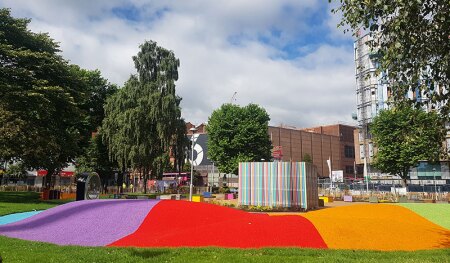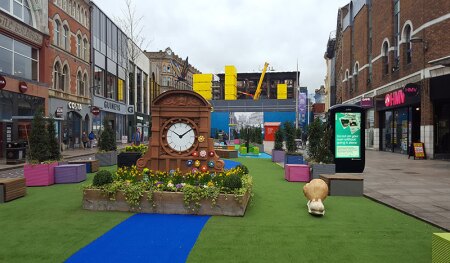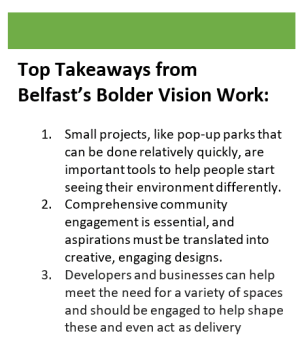This interview was conducted in July 2022 as part of a series designed to celebrate park visionaries and share inspiring and practical insights into their perspectives, challenges, and advice. Follow the series to learn from developers, planners, and other leaders creating innovative parks.
Callie Persic is a development manager with the Belfast City Council, leading Belfast’s Connectivity Programme and city center project, “A Bolder Vision for Belfast.” Working with cross-sector stakeholders and the community in Northern Ireland, she brings innovation and creativity to solve problems and find solutions to the challenges facing Belfast.
UL: How do you define a park? How do you think about the role that parks play in communities?
One definition of a park that immediately comes to mind is simply a big green space. Belfast has large green spaces as well as many other types of spaces that fall under the park definition umbrella. We have pop-up parks, linear parks, a network of green open spaces, and active and passive areas. What is most important is how the parks function and how people use them. In Belfast, a post–violent conflict city that is still highly segregated, physical connectivity through open spaces is very important and a way to bring people together. Our new city vision is about a people-focused Belfast that prioritizes connections, health and well-being, climate, and sustainable transport.
What drew you to working on parks and public spaces? How did your earlier career prepare you for the work you do now? What is most important to you about the work?
I am an American who came to Ireland over 20 years ago for my PhD in anthropology, where I focused on women and community development. In school and my early career in community development, I spent a lot of time thinking about how to engage people in their neighborhoods to shape the environment and promote stewardship. A logical next step was to work in city regeneration, which is what I do now. This is especially important in Belfast after the Troubles, a conflict that ended in 1998 with the Good Friday Agreement. During the conflict in the 1970s, permanent “Peace Walls” were built to separate Catholic and Protestant districts of Belfast, and almost 100 of them still separate mainly working-class neighborhoods in these interface areas. Near these walls, there are still derelict areas and blight that could be improved to create a better environment for residents. In a cold and gray climate, beauty and color are particularly important.
One of my first experiences creating meaningful places was as a volunteer in my own interface neighborhood that was surrounded on all sides by derelict land. I was part of a local community group that hoped to create a space where people could meet and share common ground. My neighbors and I created a pop-up garden named Peas Park [a play on words for peace and peas], and 12 years later it is still engaging community members.
Tell me about a parks project you think is most impactful and why it is important.
Peas Park, mentioned earlier, has been very impactful in providing common ground in a segregated neighborhood where a new generation of children could play together. These children did not experience the Troubles, yet they live with some of the resulting separations that still exist. The park provides them with a common space that softens the interface between the two neighborhoods and brings in gardening, art, and play.
I worked on another pop-up space more recently when the historic Bank Buildings burned down in the center of Belfast, causing road closures and limiting the ability to move between different parts of the city. I was tasked with creating an intervention to bring people back to the heart of the city. We created a small but transformational park that was geared to children and families. This park had an impact at strategic and practical levels because people started seeing their city differently and the park shaped new policies and future projects in the city center. People were disappointed when the roads reopened and the pop-up space ended, so we worked quickly to create another pop-up park nearby to meet the new demand. The next space was Cathedral Gardens Park, located in the city center, which transformed a poorly designed, underused open space into a colorful, fun gathering place. The learning from both pop-up experiences shaped the city’s Resilience Strategy and the designs for a more permanent project in Cathedral Gardens.
Both projects involved risk and venturing into the unknown because we were not sure what would work in our new spaces, especially when we decided to put play in the heart of the city. We talked to children and families to create a wish list for what they wanted. The space features new lighting and fun equipment including a giant spinning “hamster” wheel, outdoor musical instruments, and colorful mushrooms on a carpet of rainbow grass. It also features new benches and picnic tables to encourage people to relax in the park’s colorful surroundings. What we found was that people of all ages want to play—children instinctively know what to do, and I even saw grown men in suits running across the colored mounds in the pop-up park.
How do parks and public spaces intersect with issues of racial equity and social justice? How do you think about equitable access to parks?
Belfast has a low residential population in the city center because many people moved to the suburbs during the time of the Troubles, causing the population to decrease. Our current work is focused on regeneration that supports population growth and strategies to make the city center welcoming for families, retirees, and a mixture of all types of people. This is a key element of the new “Bolder Vision” for our city center.
The city still has a lot of healing to do. Neighborhoods around the city haven’t felt the benefits of the peace process equally. The remaining “Peace Walls” separate Catholic and Protestant working-class neighborhoods, limiting access to parks and open space throughout the city. While the walls may provide a sense of safety, there are often unintended negative consequences. In these areas, people often have negative health outcomes and low educational attainment, so parks are needed to improve quality of life.
How do parks promote sustainability, social connections, and public health?
Parks provide refuge for people to improve their mental and physical health. If you are wealthy, you can often have your own private space. In Belfast, high density is common in low-income areas where there is not much private green space, so parks provide an essential space for recreation and social cohesion. At the city [government level], we are also looking at the assets within the parks in terms of resilience and we have adopted nature-based climate solutions throughout our park system. We have focused on designs that provide carbon capture, flood mitigation, and protection from tidal surges. As part of our climate goals, we are working with city partners to plant 1 million native trees across Belfast by 2035.
If you had unlimited funds for parks, what would you do?
I would engage people! I would take time to create a long-term, comprehensive process to bring people of all ages, genders, and abilities together to decide what would improve their quality of life. This is about really reaching out, across ages and demographics, to shape the space based on community engagement. If I had unlimited funds, I would use them to not just shape the design, but start to build that community of future users, create social cohesion, and build connections between people. After any community engagement, I would be sure that aspirations are translated into creative, engaging designs using good quality, durable materials. Critical to all this is the ongoing management and maintenance of these spaces and future costs for upkeep and programming.
What is a park failure you’ve been involved with?
While Peas Park is a success, it has also been my biggest failure. When it opened, it was loved by everyone and people wanted to see positive change in the area. Within a week it was totally vandalized, which was heartbreaking. We decided to challenge the behaviors and had a festival event where local families planted trees in the park. The event helped with community buy-in, and weeks went by without any vandalism. However, in the short term, the initial space didn’t flourish because it was seen as everybody’s space, but it was also nobody’s space. It was not clear whose job it was to manage the park, and no one wanted to take responsibility for the ongoing function of the space. We continued to reshape the structure of responsibilities in the park and the relationships among the people, which is challenging in a voluntary project. Peas Park now has a core group of volunteers who manage the space and organize seasonal events during holidays. This programming has contributed to the success of the park.
How has the pandemic changed the way people interact with parks? What is likely to last?
Parks are part of the wider ecosystem of the city—they are as important as libraries or health centers. During the pandemic, I noticed that groups of teenagers would come to parks to walk together and hang out, so I think we need to provide more opportunities for different groups of people in parks. Just like retail is diversifying and becoming more experiential to meet market demand, parks need to be not just green open space but have a form and function to support new lifestyles. Diversity in park spaces and programming is quite important in meeting the goals of resilience, social cohesion, and access to green space, and I see this demand continuing.
What do ULI members need to know about parks and cities?
Parks and open spaces can be for everyone when they are designed for everyone. Careful upfront consultation and engagement with users is critical. We don’t want poorly designed, leftover spaces, so we need to build in fun and beauty.
Parks are critical social infrastructure and fundamental to creating a livable city. Quality of life is potentially the most important driver in creating spaces for people in cities, so this is about going beyond minimum green space requirements and creating a people-focused environment.
Engagement should be at the heart of placemaking. Developers and businesses can help meet the need for a variety of spaces and should be engaged to help shape these and even act as delivery partners.
Read about the other leaders featured in the Park Visionary series:
- Kartini Omar, National Parks Board, Singapore
- Scott Kratz, Building Bridges Across the River, Washington, D.C.
- Happy Haynes, Denver Parks and Recreation, Denver, Colorado
- Corey Wilson, Recreation and Park Commission, East Baton Rouge, Louisiana








